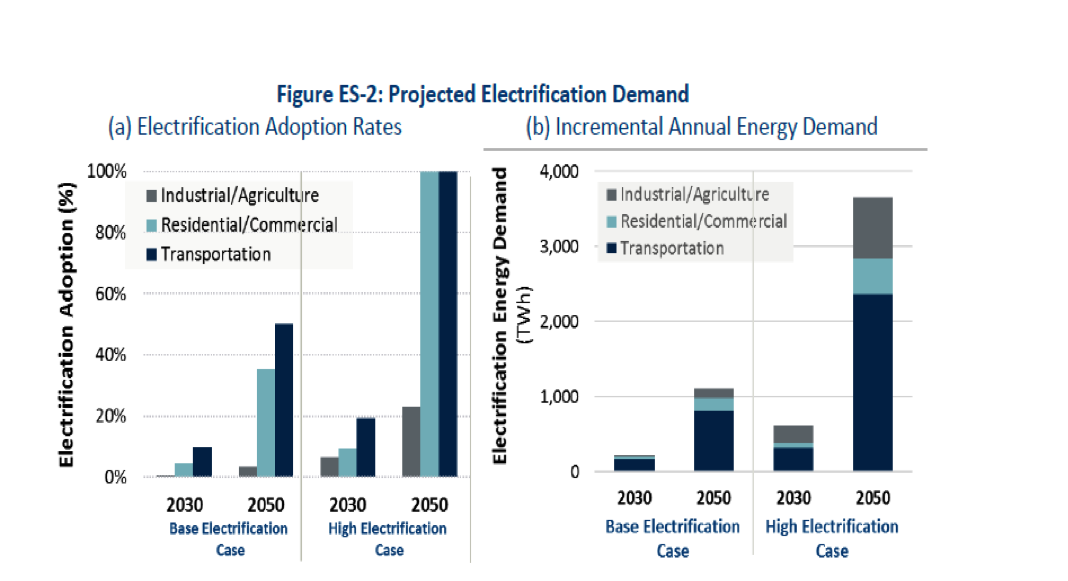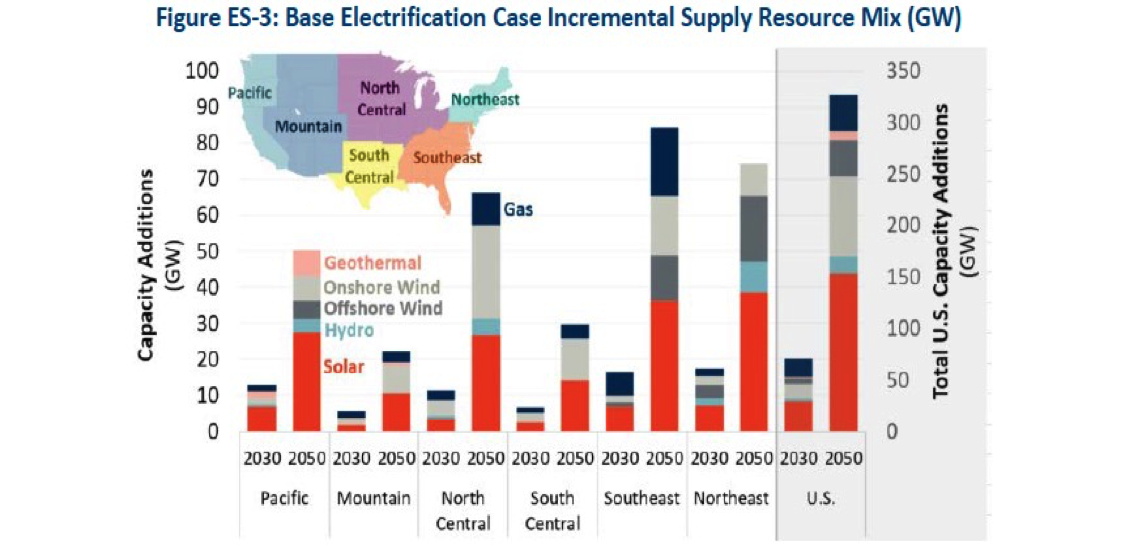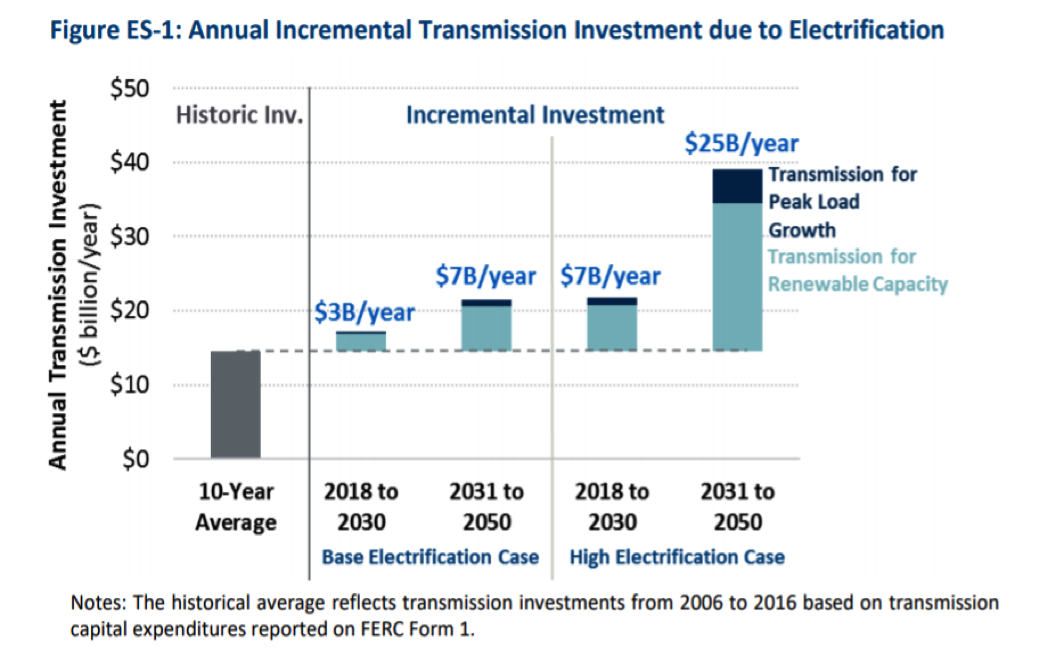According to a report released by the WIRES group, the transmission trade association, the Brattle Group evaluated two scenarios that involved increased generation due to the electrification of transportation, space heating, and advanced industrial technologies that would require billions of dollars in transmission investments over the next several decades. Electrification could increase U.S. annual electricity demand by 5 percent to 15 percent by 2030, and up to 85 percent by 2050. The transmission investment required to accommodate new renewable resources could reach $90 billion by 2030 and over $600 billion by 2050. These investments are in addition to the investments needed to maintain the existing transmission system and to integrate renewable generation built to meet the existing load.
Increased Electrification in Transportation, Heating, and Industrial Processes
There are one million electric cars on the road in the United States and the Edison Electric Institute projects 7 million electric cars by 2025. Auto manufacturers have announced over 60 new electric light-duty vehicle models, released electric buses, and several electric commercial vans, and have started to develop electric pickup trucks and semi-trucks that may be available in the early 2020s. Electric heat pumps that were traditionally used in moderate climates are now becoming more efficient in colder climates. And advances in technology could make electrifying industrial processes possible. Increased electrification may significantly increase electricity demand.
If increased electrification occurs and if renewable electricity sources are built to meet the demand, additional transmission and distribution infrastructure will be needed. More infrastructure will be needed 1) to connect additional renewable generation resources to serve the increased demand and 2) to ensure that the electricity system remains reliable with increasing peak demands.
Brattle Study Assumptions
The Brattle Study analyzes two cases: the base electrification case and the high electrification case. In the base electrification case, electric transportation becomes the dominant transportation technology and heat pumps penetrate a significant portion of the housing stock between 2030 and 2050. In the high electrification case, the study assumes that electrification powers all transportation and space and water heating needs by 2050.
The following chart shows the adoption rates and the increased electricity demand by sector for each scenario:

Between 70 gigawatts to 200 gigawatts of additional new generating capacity would be needed by 2030 to meet the additional electrification demand, assuming a 75 percent share of renewable resources and a 25 percent share of natural-gas fired generation. Assuming the share of renewable generation increases to 90 percent by 2050, an additional 200 gigawatts to 800 gigawatts of generating capacity will be needed between 2030 and 2050. These are in addition to capacity added to meet expected load demand for traditional electricity end-users outside of the increased electrification assumptions.
The Brattle study takes into account regional differences due to resource availability, technology costs, and policy objectives in determining the mix of renewable technologies to meet the increased demand, as the following chart shows.

Transmission Investment Required to Meet Assumptions
The study projects that $30 to $90 billion of incremental transmission investments will be needed by 2030, and an additional $200 to $600 billion will be needed from 2030 to 2050 to meet the increased electrification assumptions, which are in addition to maintaining the existing transmission system and to integrate new renewables to meet existing load. The following figure shows that the level of investment is equivalent to $3 to $7 billion annually on average through 2030 and $7 to $25 billion annually between 2030 and 2050. The 2030 figures represent a 20 to 50 percent increase over average annual spending on transmission over the past 10 years, and the 2030 to 2050 figures represent a 50 to 170 percent increase in the annual historic transmission investment.

Current Transmission Project under Consideration
To take advantage of abundant renewable energy in the Upper Midwest and Great Plains, two European firms are backing a $2.5 billion project to transmit renewable electricity underground. According to the project developer, Siemens and a Danish investment fund (Copenhagen Infrastructure Partners) want to build and operate a 349-mile transmission line that would transmit wind and solar power from Iowa into the Chicago area. The link would allow renewable energy from the Upper Midwest to be transmitted to the eastern United States by hooking up to the PJM Interconnection—a power grid that serves 13 states.
The majority of the line would be built underground in a Canadian Pacific railroad corridor that may make it easier to obtain permits and local permission. It will use direct-current technology, instead of alternating current, so that it does not interfere with railroad signals. It will be capable of carrying 2,100 megawatts—about the energy of a large nuclear-power plant. If approved, developers plan to have the line operational by 2024. Above ground efforts, which are about half as expensive per mile as underground lines, have been hampered by permitting delays as well as local and political opposition, which is likely to escalate if increasing electrification drives the need for more transmission.
Conclusion
The Brattle study assumes rapid growth of electrified vehicles, electric heating, and some industrial processes to evaluate the cost of the additional transmission that would be needed to accommodate the electricity supplied mostly by additional renewable generating technologies to meet the increased demand. The infrastructure requirements would be massive for such an undertaking, requiring not only new electric generating technologies and new transmission lines, but a massive number of charging stations for electric vehicles. Frequently, infrastructure costs are overlooked in evaluating increased costs of electrification and increased renewable capacity. These costs are not insignificant, and public opposition is growing to new transmission facilities, especially above ground lines despite their lower cost.



